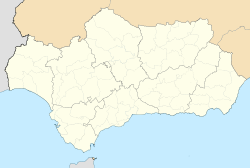Cape Trafalgar facts for kids
Quick facts for kids Cape Trafalgar |
|
|---|---|
| Cabo de Trafalgar | |

Cape Trafalgar lighthouse
|
|
| Coordinates | 36°11′N 6°2′W / 36.183°N 6.033°W |
| Geology | Cape |
Cape Trafalgar (pronounced tra-FAL-gar) is a famous piece of land that sticks out into the Atlantic Ocean in southwest Spain. It's located in the Province of Cádiz. The cape is also known as Cabo Trafalgar in Spanish.
This cape is well-known for a very important naval battle that happened nearby in 1805. This was the Battle of Trafalgar. In this battle, the Royal Navy from Britain, led by Admiral Horatio Nelson, won a big victory. They defeated the combined fleets of Spain and France, which were under Napoleon's command.
Cape Trafalgar sits on the coast of the Atlantic Ocean. It is northwest of the Strait of Gibraltar. This strait is a narrow waterway that connects the Atlantic Ocean to the Mediterranean Sea. The western edge of the Strait of Gibraltar is officially marked by a line. This line connects Cape Trafalgar in the north to Cape Spartel in the south.
The most noticeable building on the cape is a tall lighthouse. It is called the Faro de Cabo Trafalgar. The lighthouse is 34 meters (112 feet) tall. Its light shines from 51 meters (167 feet) above sea level. This important lighthouse first lit up the night on July 15, 1862.
What's in a Name?
The name Trafalgar comes from the Arabic language. It likely comes from one of two phrases. One idea is Taraf al-Ghar, which means 'cape of the cave' or 'cape of the laurel'. The other idea is Taraf al-Gharb, meaning 'cape of the west'.
In both cases, the Arabic word taraf means 'edge' or 'extremity'. This makes sense because a cape is a piece of land at the edge of the coast. Today, in modern Arabic, the place is sometimes called al-Taraf al-Aghar.
Ancient Discoveries
In May 2021, something exciting was found at Cape Trafalgar. Old Roman baths that were 2,000 years old appeared from under the sand dunes. These ancient baths included whole walls, windows, and even doors. It was like stepping back in time!
See also
 In Spanish: Cabo Trafalgar para niños
In Spanish: Cabo Trafalgar para niños





